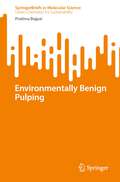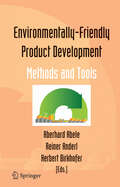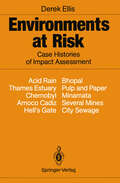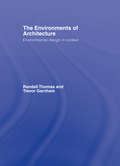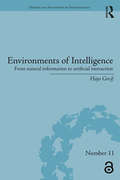- Table View
- List View
Environmentally-Benign Energy Solutions (Green Energy and Technology)
by Ibrahim Dincer Can Ozgur Colpan Mehmet Akif EzanThis book provides high-quality research results and proposes future priorities for more sustainable development and energy security. It covers a broad range of topics on atmospheric changes, climate change impacts, climate change modeling and simulations, energy and environment policies, energy resources and conversion technologies, renewables, emission reduction and abatement, waste management, ecosystems and biodiversity, and sustainable development. Gathering selected papers from the 7th Global Conference on Global Warming (GCGW2018), held in Izmir, Turkey on June 24–28, 2018, it: Offers comprehensive coverage of the development of systems taking into account climate change, renewables, waste management, chemical aspects, energy and environmental issues, along with recent developments and cutting-edge information Highlights recent advances in the area of energy and environment, and the debate on and shaping of future directions and priorities for a better environment, sustainable development and energy security Provides a number of practical applications and case studies Is written in an easy-to-follow style, moving from the basics to advanced systems. Given its scope, the book offers a valuable resource for readers in academia and industry alike, and can be used at the graduate level or as a reference text for professors, researchers and engineers.
Environmentally Benign Photocatalysts: Applications of Titanium Oxide-based Materials (Nanostructure Science and Technology)
by Masakazu Anpo Prashant V. V. KamatOver the past few decades, mankind has observed an unprecedented and remarkable growth in industry, resulting in a more prosperous lifestyle for peoples of many countries. In developing countries, however, explosive industrial growth is just now beginning to raise the living standards of the people. Most industries, especially in these developing countries, are still powered by the burning of fossil fuels; con- quently, a lack of clean energy resources has caused environmental pollution on an unprecedented large and global scale. Toxic wastes have been relentlessly released into the air and water leading to serious and devastating environmental and health problems while endangering the planet and life itself with the effects of global warming. To address these urgent environmental issues, new catalytic and photocatalytic processes as well as open-atmospheric systems are presently being developed that can operate at room temperature while being totally clean and ef?cient and thus environmentally harmonious. Essential to technologies harnessing the abundant solar energy that reaches the earth are the highly functional photocatalytic proce- es that can utilize not only UV light, but also visible light.
Environmentally Benign Pulping (SpringerBriefs in Molecular Science)
by Pratima BajpaiThis book provides the most up-to-date and comprehensive information on the state-of-the-art techniques and aspects involved in environment-friendly pulping technologies. Traditional chemical and semi-chemical pulping processes are not environmentally friendly. Therefore, it has become important to look for alternative approaches to mitigate wastewater emissions in the paper industry, by making more stringent regulations to improve environmental conservation. In response to this problem, new raw materials need to be explored to replace traditional choices and also new pulping processes need to be developed based on less polluting, more easily recovered reagents. This book presents new and emerging deep eutectic solvents for lignocellulosic biomass pretreatment, and discusses the effects of deep eutectic solvents on biomass pretreatment and the production of value-added products. It also introduces biotechnological methods of pulping. Biotechnological processes help to make manufacturing processes cleaner and more efficient by reducing toxic chemical pollution and greenhouse gas emissions. Given its scope, this book is of interest to applied chemists, foresters, chemical engineers, wood scientists, along with engineers and researchers involved in the pulp and paper industry as a valuable reference.
Environmentally Friendly Alkylphosphonate Herbicides
by Hong-Wu He Hao Peng Xiao-Song TanThis book presents essential research on a class of environmentally friendly alkylphosphonate herbicides. This class of herbicides acted as a competitive inhibitor of the pyruvate dehydrogenase complex (PDHc) to control weeds. The bioreasoning and systematic approach, from basic research to field tests of candidate compounds, are introduced. The basic research covers the molecular design, chemical synthesis, biological activities evaluation, structure-activity relationship analysis and structural optimization. Subsequently, the book reviews the biochemistry of PDHc inhibitors, the selectivity between mammals and plants, and the mechanism of herbicidal activity of novel alkylphosphonates as selective PDHc inhibitors. Field trials for selected alkylphosphonate candidates as herbicides are also included. This book provides a sound basis for the rational design and development of novel herbicides as effective PDHc inhibitors with good enzyme-selective inhibition of plant PDHc between mammals and plants. These studies take full advantages of the low toxicity and low residual impact of selective PHDc inhibitors to design an effective and environmentally friendly herbicide. This book is based on twenty years of research on alkylphosphonates and phosphorus-containing PDHc inhibitors, and demonstrates how to develop these PDHc inhibitors as an effective and “green” herbicide candidate.Hong-Wu He, PhD, is a Professor at the Key Laboratory of Pesticide & Chemical Biology, Ministry of Education of China, and Director of the Institute of Pesticide Chemistry, College of Chemistry, Central China Normal University, China.Hao Peng, PhD, and Xiao-Song Tan are both Associate Professors at the Key Laboratory of Pesticide & Chemical Biology, Ministry of Education of China, College of Chemistry, Central China Normal University, China.
Environmentally Friendly and Biobased Lubricants
by Brajendra K. Sharma and Girma BiresawA Comprehensive Review of Developing Environmentally Friendly Lubricants A push from environmentally savvy consumers along with recent changes in governmental regulations have paved the way for a marketplace of products with high levels of environmental performance. Fueled by the growing demand for biobased lubricants, Environmentally Friendly and Biobased Lubricants highlights the development of environmentally friendly additives that are compatible with environmental regulations and describes the approaches being used in this emerging area. Derived from research topics shared over the years at various technical sessions of the Society of Tribologists and Lubrication Engineers (STLE) Annual Meetings, the book includes a critical assessment of gaps and weaknesses in the field of environmentally friendly fluids and biobased lubricants. Each chapter is written by authors selected from the environmentally friendly fluids and biobased lubricants sessions of STLE and also incorporates input from prominent researchers invited to take part in the book. Expert contributors discuss the control, production, usage, and disposal of lubricants; factor in related policies, laws, and regulations around the world; and include case studies demonstrating the uses and values of commercially viable biobased lubricants. The book is divided into five sections that cover advanced environmentally friendly base oils and feedstocks, biobased hydraulic lubricants and biodegradability, chemically/enzymatically modified environmentally friendly base oils, vegetable oil–based environmentally friendly fluids, and additives for environmentally friendly fluids.
Environmentally Friendly and Biobased Lubricants
by Brajendra K. Sharma Girma BiresawA Comprehensive Review of Developing Environmentally Friendly Lubricants A push from environmentally savvy consumers along with recent changes in governmental regulations have paved the way for a marketplace of products with high levels of environmental performance. Fueled by the growing demand for biobased lubricants, Environmentally Friendly and Biobased Lubricants highlights the development of environmentally friendly additives that are compatible with environmental regulations and describes the approaches being used in this emerging area. Derived from research topics shared over the years at various technical sessions of the Society of Tribologists and Lubrication Engineers (STLE) Annual Meetings, the book includes a critical assessment of gaps and weaknesses in the field of environmentally friendly fluids and biobased lubricants. Each chapter is written by authors selected from the environmentally friendly fluids and biobased lubricants sessions of STLE and also incorporates input from prominent researchers invited to take part in the book. Expert contributors discuss the control, production, usage, and disposal of lubricants; factor in related policies, laws, and regulations around the world; and include case studies demonstrating the uses and values of commercially viable biobased lubricants. The book is divided into five sections that cover advanced environmentally friendly base oils and feedstocks, biobased hydraulic lubricants and biodegradability, chemically/enzymatically modified environmentally friendly base oils, vegetable oil–based environmentally friendly fluids, and additives for environmentally friendly fluids.
Environmentally Friendly Coastal Protection: Proceedings of the NATO Advanced Research Workshop on Environmentally Friendly Coastal Protection Structures, Varna, Bulgaria, 25-27 May 2004 (Nato Science Series: IV: #53)
by Claus Zimmermann Robert G. Dean Valeri Penchev Henk Jan VerhagenCoast lines have been and still are the central lines of civilization around the world with still increasing pressure from both sides – the hinterland and the sea – with all its foreseeable and unforeseeable impacts by means of nature or mankind. While the response of nature to such impacts is flexible in the way that all morphological changes with all the consequences are tolerated as part of the system, humanity cannot tolerate short-term or long-term changes without being threatened in its physical and economical existence. The objectives of this Advanced Research Workshop (ARW) on Environmentally Friendly Coastal Structures were: - to contribute to the critical assessment of existing knowledge in the field of coastal and environmental protection;- to identify directions for future research in that area;- to promote close working relationships between scientists from different countries and with different professional experience. The latest trends in research on coastal and environmental protection were summarized and developed during the meeting. Seventeen papers are presented in this book, attempting to cover all related aspects as completely as possible – coast, engineering structures, water, sediments, ecosystems in their complicated interaction.
Environmentally Friendly Machining (SpringerBriefs in Applied Sciences and Technology)
by U.S. Dixit D.K. Sarma J. Paulo DavimEnvironment-Friendly Machining provides an in-depth overview of environmentally-friendly machining processes, covering numerous different types of machining in order to identify which practice is the most environmentally sustainable. The book discusses three systems at length: machining with minimal cutting fluid, air-cooled machining and dry machining. Also covered is a way to conserve energy during machining processes, along with useful data and detailed descriptions for developing and utilizing the most efficient modern machining tools. Researchers and engineers looking for sustainable machining solutions will find Environment-Friendly Machining to be a useful volume.
Environmentally-Friendly Product Development: Methods and Tools
by Eberhard Abele Reiner Anderl Herbert BirkhoferDevelopment of environmentally friendly products gains an increasing - portance in science and in industry. While product development was strongly dedicated to achieve quality, cost and time targets, environmental issues indirectly had always been under consideration by engineers, see Fig. 1. Furthermore a methodology for the development of environm- tally sound products was missing. Despite of significant progress in using computer aided tools for product development and design, environmental aspects were attended. Computer aided tools typically do not include methods for considering environmental issues enabling the designer to - sess a product’s environmental effects. Fig. 1. Vision of Environment as a key target for product development v vi Preface Product related environmental issues are getting more and more political and public awareness. Development of environmentally friendly products has become an action item for both, politics and industry (UNFCCC 1997). Energy consumption is on the agenda and covers pollution and resource saving. Typical topics of directives of the European Union are waste, noise, air pollution, water, nature and biodiversity, soil protection, civil protection and climate change. After the translation into national law the development of environmentally friendly products is a basic approach to contribute to the fulfilment of the topics mentioned above. In the European Community a “Communication from the Commission to the Council and the European Parliament” on “Integrated Product Policy” was adopted on th 18 June 2003 (EC 2003).
Environmentally Friendly Syntheses Using Ionic Liquids
by Jairton Dupont Toshiyuki Itoh Pedro Lozano Sanjay MalhotraIncreased environmental consciousness within the scientific community has spurred the search for environmentally friendly processes as alternatives to conventional organic solvents. In the past two decades, numerous advances-including the use of ionic liquids-have made it possible to develop substitutes for some toxic solvents. Ionic liquids are wi
Environmentally Sustainable Catalytic Asymmetric Oxidations
by Konstantin BryliakovCatalysis plays a vital role in chemical, petroleum, agriculture, polymer, electronics, pharmaceutical, and other industries. Over 90 percent of chemicals originate from catalytic processes. Toughening economic and environmental constraints have proven to be a challenge for meeting the demand of novel efficient and sustainable regio- and stereosele
Environmentally Sustainable Viticulture: Practices and Practicality
by Chris GerlingThis title includes a number of Open Access chapters.As climate change becomes a growing reality, more industries must grapple with how to implement sustainable business practices at every step of the production process. This is especially true for viticulture, where every step of production can take years to come to fruition, and any decision made
EnvironmentalStats for S-Plus®: User’s Manual for Version 2.0
by Steven P. MillardThis is the User's Manual to the software package EnvironmentalStats for S-PLUS, which is an add-on module for S-PLUS providing the first comprehensive software package for environmental scientists, engineers, and regulators. The new edition provides the documentation for Version 2.0 (which runs under S-PLUS 6.0), and includes extensive examples using real data sets.
Environments at Risk: Case Histories of Impact Assessment
by Derek EllisEnvironments at Risk is designed as an introductory text and uses case histories of environmental impact assessment to raise issues important in controlling environmental problems. This approach is novel as is the concentration on assessment procedures. In his twenty years of involvement with such cases, Professor Ellis developed his own method of approach for auditing environmental impact assessments, a method which will help readers appraise similar cases in which they are involved, either as concerned citizen, environmental managers or assessors.
The Environments of Architecture: Environmental Design in Context
by Randall Thomas Trevor GarnhamThis well-illustrated 'think piece' provides a much needed and topical philosophical introduction to the place of environmental design in architecture. The Environments of Architecture sets out a range of considerations necessary to produce appropriate internal environments in the context of a wider discussion on the effect of building decisions on the broader environment. The authors, from architecture and engineering, academia and practice, provide a rounded and well-balanced introduction to this important topic. Starting from a belief that the built environment can contribute more positively to the planet and the pleasure of places as well as answering the practical demands of comfort, they cover site planning, form, materials, construction and operation as well as looking at design on a city level. Presenting a thoughtful and stimulating approach to the built environment, this book forms an excellent guide for practitioners, students and academics concerned with our built environment.
The Environments of Architecture: Environmental Design in Context
by Randall Thomas Trevor GarnhamThis well-illustrated 'think piece' provides a much needed and topical philosophical introduction to the place of environmental design in architecture. The Environments of Architecture sets out a range of considerations necessary to produce appropriate internal environments in the context of a wider discussion on the effect of building decisions on the broader environment. The authors, from architecture and engineering, academia and practice, provide a rounded and well-balanced introduction to this important topic. Starting from a belief that the built environment can contribute more positively to the planet and the pleasure of places as well as answering the practical demands of comfort, they cover site planning, form, materials, construction and operation as well as looking at design on a city level. Presenting a thoughtful and stimulating approach to the built environment, this book forms an excellent guide for practitioners, students and academics concerned with our built environment.
Environments of Empire: Networks and Agents of Ecological Change (Flows, Migrations, and Exchanges)
by Brett M. Bennett Ulrike KirchbergerThe age of European high imperialism was characterized by the movement of plants and animals on a historically unprecedented scale. The human migrants who colonized territories around the world brought a variety of other species with them, from the crops and livestock they hoped to propagate, to the parasites, invasive plants, and pests they carried unawares, producing a host of unintended consequences that reshaped landscapes around the world. While the majority of histories about the dynamics of these transfers have concentrated on the British Empire, these nine case studies--focused on the Ottoman, French, Dutch, German, and British empires--seek to advance a historical analysis that is comparative, transnational, and interdisciplinary to understand the causes, consequences, and networks of biological exchange and ecological change resulting from imperialism. Contributors: Brett M. Bennett, Semih Celik, Nicole Chalmer, Jodi Frawley, Ulrike Kirchberger, Carey McCormack, Idir Ouahes, Florian Wagner, Samuel Eleazar Wendt, Alexander van Wickeren, Stephanie Zehnle
Environments of Intelligence: From natural information to artificial interaction (History and Philosophy of Technoscience)
by Hajo GreifWhat is the role of the environment, and of the information it provides, in cognition? More specifically, may there be a role for certain artefacts to play in this context? These are questions that motivate "4E" theories of cognition (as being embodied, embedded, extended, enactive). In his take on that family of views, Hajo Greif first defends and refines a concept of information as primarily natural, environmentally embedded in character, which had been eclipsed by information-processing views of cognition. He continues with an inquiry into the cognitive bearing of some artefacts that are sometimes referred to as 'intelligent environments'. Without necessarily having much to do with Artificial Intelligence, such artefacts may ultimately modify our informational environments. With respect to human cognition, the most notable effect of digital computers is not that they might be able, or become able, to think but that they alter the way we perceive, think and act. The Open Access version of this book, available at http://www.tandfebooks.com/doi/view/10.4324/9781315401867, has been made available under a Creative Commons CC-BY licence
Environments of Intelligence: From natural information to artificial interaction (History and Philosophy of Technoscience)
by Hajo GreifWhat is the role of the environment, and of the information it provides, in cognition? More specifically, may there be a role for certain artefacts to play in this context? These are questions that motivate "4E" theories of cognition (as being embodied, embedded, extended, enactive). In his take on that family of views, Hajo Greif first defends and refines a concept of information as primarily natural, environmentally embedded in character, which had been eclipsed by information-processing views of cognition. He continues with an inquiry into the cognitive bearing of some artefacts that are sometimes referred to as 'intelligent environments'. Without necessarily having much to do with Artificial Intelligence, such artefacts may ultimately modify our informational environments. With respect to human cognition, the most notable effect of digital computers is not that they might be able, or become able, to think but that they alter the way we perceive, think and act. The Open Access version of this book, available at http://www.tandfebooks.com/doi/view/10.4324/9781315401867, has been made available under a Creative Commons CC-BY licence
The Environments of the Sun and the Stars (Lecture Notes in Physics #857)
by Jean-Pierre Rozelot and Coralie NeinerBased on lectures given at a CNRS summer school in France, this book covers many aspects of stellar environments (both observational and theoretical) and offers a broad overview of the field. More specifically, Part I of the book focuses on the Sun, the properties of the ejected plasma, of the solar wind and on space weather. The second part deals with tides in planetary systems and in binary stellar systems, as well as with interactions in massive binary stars as seen by interferometry. Finally the chapters of Part III discuss the environments of young or evolved stars, stellar winds, agnetic fields and disks. With its broad approach the book will provide advanced students as well as researchers with a good overview of the environments of the Sun and the stars.
Envisioning a Sustainable Development Agenda for Trade and Environment
by A. Najam M. Halle R. Meléndez-OrtizThis book systematically explores the trade and environment interests of developing countries from a Southern perspective. The contributors write explicitly about both hopes and fears in the South. Essays are from leading experts and thought leaders from various regions of the South who work for bold new agendas and priorities for their region.
Enzybiotics: Antibiotic Enzymes as Drugs and Therapeutics
by Tomas G. Villa Patricia Veiga CrespoPresents the latest research and applications for a new, promising approach to fighting infectious diseases Enzybiotics is a promising way of fighting bacterial or fungal infectious diseases by using viruses or viral-derived lysins. Drawing from the fields of medicinal chemistry, microbiology, genetics, and biochemistry, this book presents the state of the science in enzybiotics research, fully exploring its emerging therapeutic applications. The book begins with four chapters that review the potential applications, possible advantages, and phylogeny of enzybiotics. Next, the book explores: A new approach to controlling infections using Gram-negative bacteria Bacteriophage holins and their membrane-disrupting activity Anti-staphylococcal lytic enzymes Membrane-targeted enzybiotics Design of phage cocktails for therapy from a host-range point of view Novel methods to identify new enzybiotics Genetically modified phages that deliver suicidal genes to target bacteria The authors, all active enzybiotics researchers, offer a variety of perspectives, the benefit of their own hands-on investigations, as well as a thorough review and analysis of the current literature. As more and more bacteria become resistant to antibiotics, the development of new disease-fighting agents has become essential. This book demonstrates the full potential of the emerging field of enzybiotics to control infectious diseases. Moreover, it will serve as a springboard for new research and the development of new therapeutics.
Enzyklopädie der textilchemischen Technologie
by A. Bodmer K. Braungard W. Christ G. Durst R. Haller Alouis Herzog R. Hofmann W. Keiper W. Kind A. Klughardt P. Krais H. Ley Jul. Marx Manfred Richter R. RüschDieser Buchtitel ist Teil des Digitalisierungsprojekts Springer Book Archives mit Publikationen, die seit den Anfängen des Verlags von 1842 erschienen sind. Der Verlag stellt mit diesem Archiv Quellen für die historische wie auch die disziplingeschichtliche Forschung zur Verfügung, die jeweils im historischen Kontext betrachtet werden müssen. Dieser Titel erschien in der Zeit vor 1945 und wird daher in seiner zeittypischen politisch-ideologischen Ausrichtung vom Verlag nicht beworben.
Enzyklopädie Philosophie und Wissenschaftstheorie: Bd. 2: C–F
Die »Enzyklopädie Philosophie- und Wissenschaftstheorie«, das größte allgemeine Nachschlagewerk zur Philosophie im deutschsprachigen Raum, wurde 1980 begonnen und 1996 mit dem vierten Band abgeschlossen. Sie erschien 2005 bis 2018 in einer komplett aktualisierten und erweiterten 8-bändigen Neuauflage, die hiermit nun in einer kartonierten Sonderausgabe vorliegt. Die »Enzyklopädie« umfasst in Sach- und Personenartikeln nicht nur den klassischen Bestand des philosophischen Wissens, sondern auch die neuere Entwicklung der Philosophie, insbesondere in den Bereichen Logik, Erkenntnis- und Wissenschaftstheorie sowie Sprachphilosophie. Zugleich finden Grundlagenreflexionen in den Wissenschaften und deren Geschichte ausführliche Berücksichtigung. Die umfassenden Bibliographien und Werkverzeichnisse wurden für die 2. Auflage in allen Artikeln auf den neuesten Stand gebracht.
Enzyklopädie Philosophie und Wissenschaftstheorie: Bd. 4: Ins–Loc
Die »Enzyklopädie Philosophie- und Wissenschaftstheorie«, das größte allgemeine Nachschlagewerk zur Philosophie im deutschsprachigen Raum, wurde 1980 begonnen und 1996 mit dem vierten Band abgeschlossen. Sie erschien 2005 bis 2018 in einer komplett aktualisierten und erweiterten 8-bändigen Neuauflage, die hiermit nun in einer kartonierten Sonderausgabe vorliegt. Die »Enzyklopädie« umfasst in Sach- und Personenartikeln nicht nur den klassischen Bestand des philosophischen Wissens, sondern auch die neuere Entwicklung der Philosophie, insbesondere in den Bereichen Logik, Erkenntnis- und Wissenschaftstheorie sowie Sprachphilosophie. Zugleich finden Grundlagenreflexionen in den Wissenschaften und deren Geschichte ausführliche Berücksichtigung. Die umfassenden Bibliographien und Werkverzeichnisse wurden für die 2. Auflage in allen Artikeln auf den neuesten Stand gebracht.


